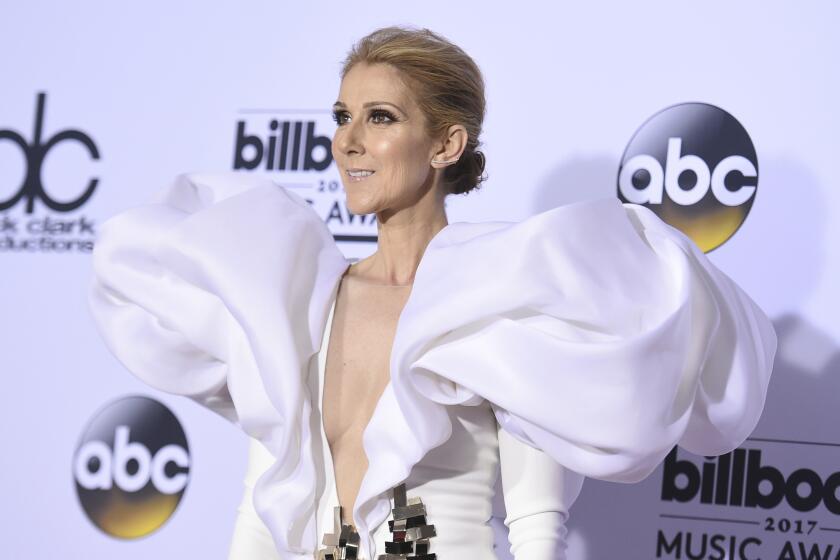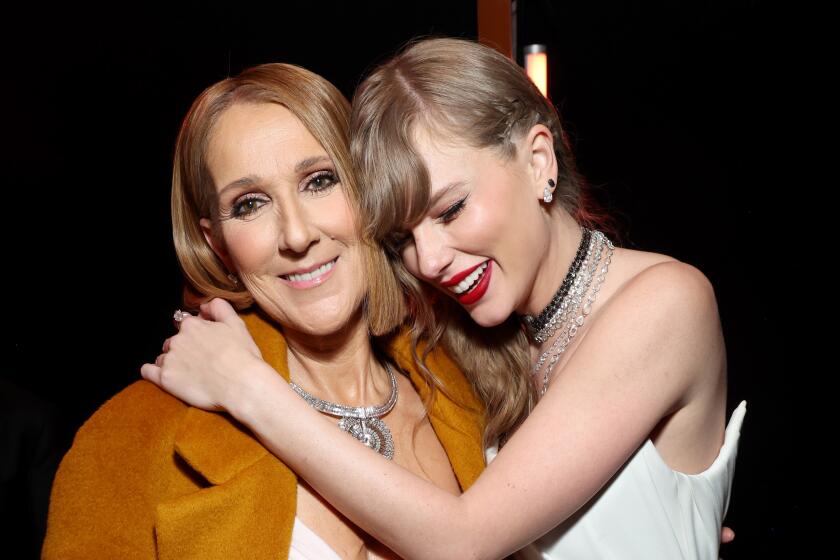‘Don’t cut down that scene’: ‘I Am: Celine Dion’ director on capturing singer’s seizure
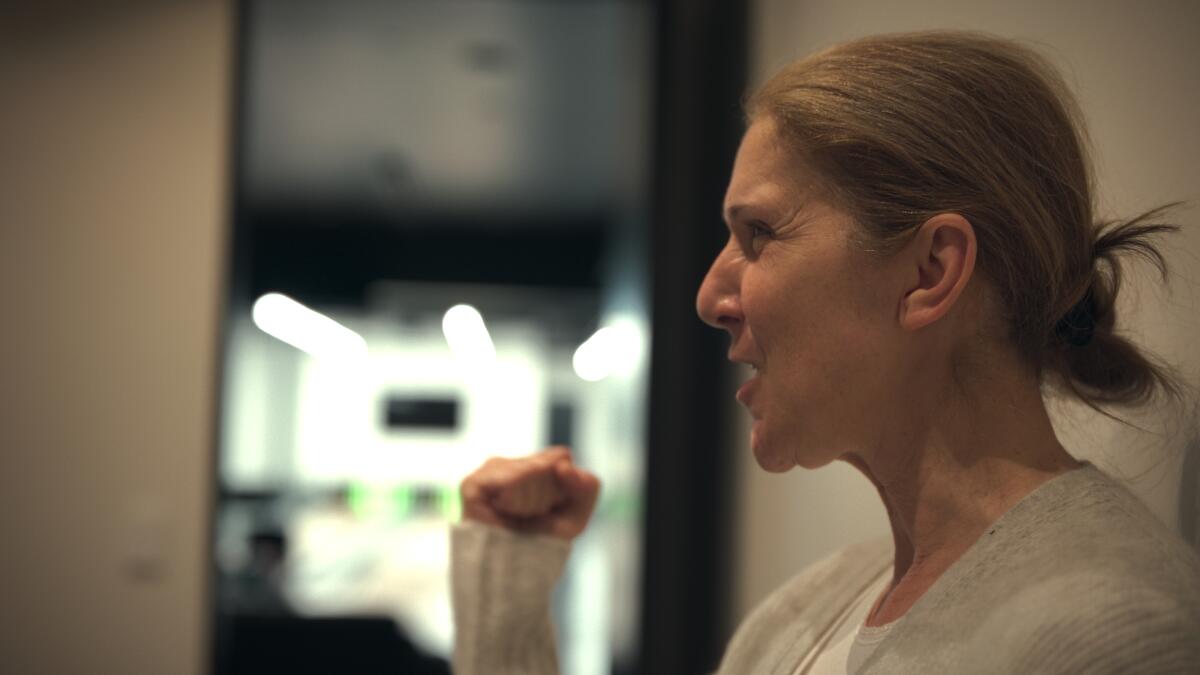
- Share via
NEW YORK — “This is by far the biggest crowd I’ve had in a few years,” said Celine Dion onstage at Lincoln Center last week. She was making a rare appearance to introduce “I Am: Celine Dion,” a documentary chronicling her struggles with stiff-person syndrome, a rare neurological disorder that causes muscle rigidity and has made it difficult for her to do the thing that has most defined her since childhood: sing.
“I cannot believe how fortunate I am to have my fans in my life,” Dion said, pausing to hold back tears as her son, René-Charles Angélil, who was waiting on the side of the stage, handed her a tissue. “Thank you to all of you from the bottom of my heart for being a part of my journey. This movie is my love letter to each of you. I hope to see you all again very soon.”
Director Irene Taylor was not exactly a Dion aficionado when she got a call a few years ago asking if she’d be open to making a film about the French Canadian singer who is known for her powerhouse vocals.
“Honestly, I thought it was not going to be a good fit. I don’t say that out of arrogance. I was like, “What would they want from me? This is not the kind of movie I make,” said Taylor in a video chat. Her previous documentaries include the deeply personal “Moonlight Sonata: Deafness in Three Movements,” about her deaf son and father. She was eventually won over by Dion and tried to approach her subject “with no peripheral vision,” Taylor said. “I really just tried to look at the person in front of me and what was happening.”
Celine Dion says her rare disorder, characterized by muscle rigidity and spasms, hinders her ability to perform or carry out everyday tasks.
The documentary, now streaming on Prime Video, uses clips of performances and interviews from Dion’s 40-year career and traces the basics of her biography — beginning with her childhood in Quebec, where she was the youngest of 14 children, and then her crossover journey from French-language teen star to a chart topper with power ballads like “Because You Loved Me” and “My Heart Will Go On.”
Weaving archival material with contemporary footage of Dion opening up about her health struggles, “I Am: Celine Dion” shows the singer at her most vulnerable, both emotionally and physically.
Gone are the glitz and glamour associated with her onstage persona; Dion appears mostly makeup-free in casual dress, making goofy videos with her adolescent twins. She comes off as endearingly kooky — at one point she breaks out into the Kit Kat “Gimme a break” jingle — but also self-aware and very funny, like when she delivers an impromptu monologue about her love of shoes.
She is also candid about the extent of her health issues, revealing in the film that she had, by then, been experiencing symptoms for 17 years. What first manifested through occasional vocal strain grew steadily more debilitating, forcing her to find ways to fake it on stage and cancel shows — something that she, a performer with a zealous work ethic and devotion to her fans, found nearly as painful as the physical condition itself.
Perhaps most unforgettably, the film captures Dion as she is stricken with an episode of her illness in the middle of a physical therapy session. While lying on a table, she suddenly freezes. And though she can barely make a sound, her wrenched face conveys the agony she’s experiencing. At the New York screening, audience members could be heard weeping throughout the scene.
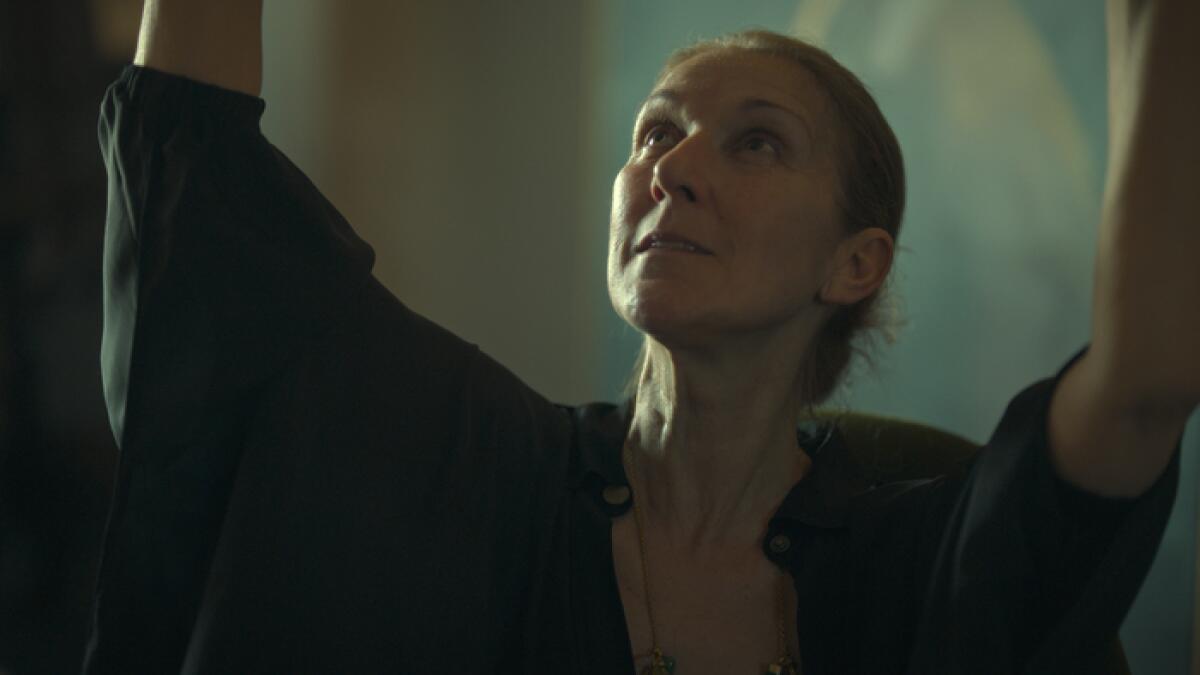
Taylor followed Dion for about a year, spending several days with her a month, and found her brave and authentic — qualities that she hopes come through in the film.
“She was down to earth with me,” she said, “so I just wanted to show the woman who showed me herself.”
Taylor spoke with The Times the day after the screening in New York. The following conversation has been edited and condensed for clarity.
Did you know about her diagnosis when you signed up to make this film?
I did not know about her illness when I signed on to do this. She had been withholding it from the world, including me. It all made sense once I talked with her. I realized it was a pretty devastating lie that she was telling people for years. Her athleticism on stage did not suggest that she was sick. Yes, she was canceling some shows, but she found ways to fake it.
In the beginning, I didn’t know what the film would be about. I didn’t really know what my take would be. I just knew it would be a portrait of her. She had asked me, “Is it possible to make a documentary where no one else is in the documentary, it’s just me?” That would sound very self-centered coming from a certain kind of person, but it was a genuine question. I told her, “It’s certainly possible, but it’s going to be a harder road for you because I need more of your time, and I need your authentic self.”
But Celine was so straight with me. She never told me to stop filming. In fact, she said, “Don’t talk to me about whether you can do something or not, because it’ll throw me off. You’re here in my home, you’ve got carte blanche, do what you need to do.” That is a profound tool to give me. She did not get involved in my editing. She did not ask me to change anything. It is a rare opportunity to be able to make a film about a public figure and have that much agency.
Céline Dion’s return to the Grammy Awards stage Sunday was a triumphant moment for the ill singer, but some viewers were upset that Taylor Swift didn’t seem to acknowledge it.
At what point did you learn about the illness?
I got a call saying, “Could we talk about this?” It was a call with someone from the record company and a couple of people from her management team and they basically said, “She’s not well, and we don’t have a name for it.” There wasn’t consensus about it. I had that information going into the first day of shooting, and then it was like a fire hose at me. “Seventeen years, I’ve been lying to everybody. I am feeling so guilty.” I was so overwhelmed that first day. I think she had been holding it in for a long time. Over the first half of filming, I was watching her flail, not knowing what she had, and the doctors not knowing what to do about it. Then over time, there was consensus, and she was very relieved when she got the diagnosis, even though it’s an orphan disease. She said to me, “I don’t want to have a rare disease. No one knows how to fix it.”
When she got that formal diagnosis, that is when she wanted to tell the world, and the way she wanted to do that was through Instagram — just tell people directly. So I pivoted in my filmmaking and decided how to incorporate her telling the world into the story.
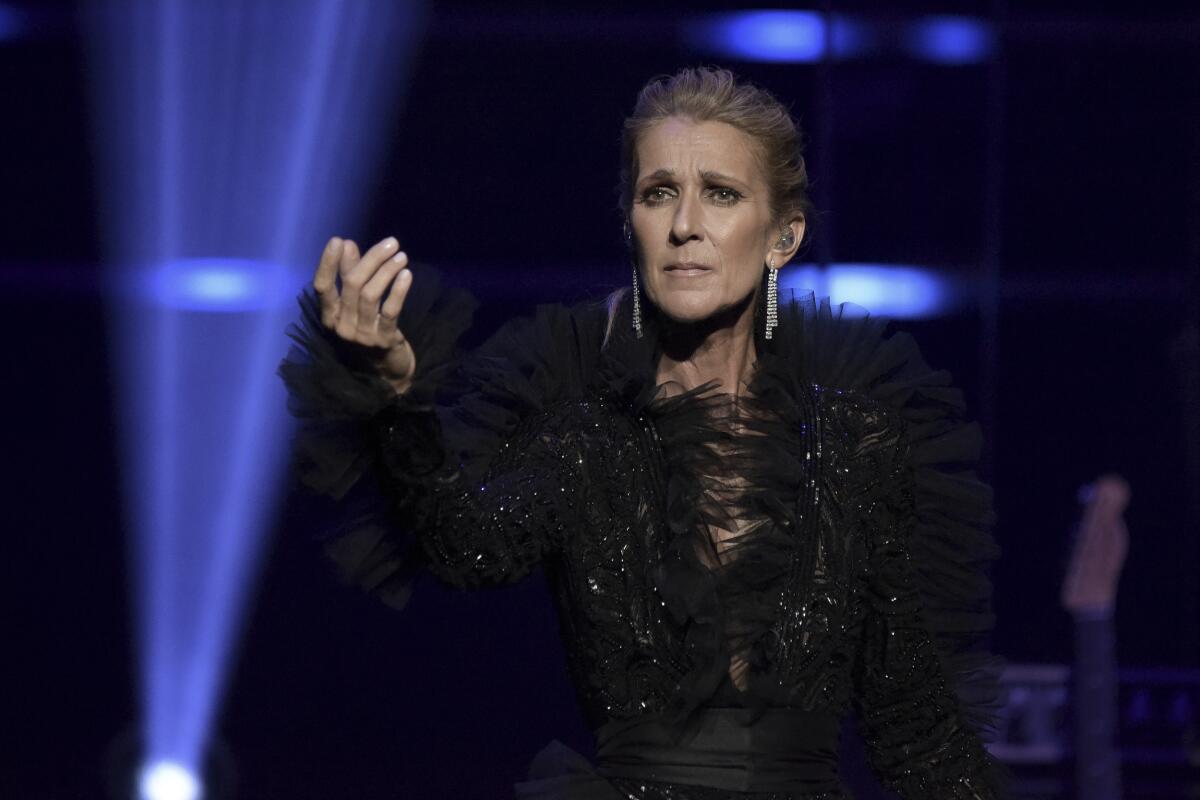
With celebrities and public figures, it can be hard to get them off of their narrative. How did you find her as an interview subject?
I had reservations about making the film, because I saw “Celine Dion” in quotes, as a very cultivated public figure. She had a persona, and I was a little cynical about that. I didn’t want to make a film about someone who had an agenda. It took getting to talk with her, and then just connecting with each other on a personal level about certain personal things. We both love trees. We both raise boys. She was very interested in picking apart everything that was in [the background on] our Zoom calls: “What’s that?” You could tell she was just trying to piece me together.
I had made very intimate films about people I know very well, like my parents and my son. I just didn’t know where she’d fit in. In the end, I realized that the fact that Celine was so used to cameras, the fact that she had lived her life under lights, actually made her a very authentic subject. I realized that, instead of [her celebrity] being something to be wary of, it actually was working in my favor, but only because she had decided, “I have nowhere else to go.” She seemed to have it all. In fact, she was living a very private lie, and she called it a lie. I was amazed at the language she was willing to use to describe herself.
We see Dion have this very intense episode, where it’s clear she’s in excruciating pain. Tell me about filming that — what was going through your head?
This all happened all in a matter of a minute. We were in a physical therapy session. We were 10 minutes out of two days of [her] recording [music] for the first time in several years. She left feeling elated, because she didn’t think she’d be able to do it. Ironically, it is that elation, that emotional high, that can trigger this kind of response. We could have turned the camera off, but we had been filming for eight months at that point, and Celine said, “Film everything.” I thought to myself, “I gotta make sure this woman’s breathing,” so I just pushed my headphones into my ear, and I listened, and I could not hear her breathing. I asked, “Is she breathing?” She was able to squeeze [the therapist’s] hand. I looked at my [director of photography], and we just kept going.
I was actually grateful that about forty minutes into the episode, you hear her therapist mention that the cameras are in the room, and he checks with her if it’s OK. I wasn’t sure what she would say in that moment, but she said it was OK. I couldn’t believe what had happened, and I was so grateful she was OK, but I realized that it might be an opportunity, if Celine was up for it, to really show and really validate her suffering.
Six months later, I showed her a rough cut of the film. I was very nervous. I knew there was no way I would ever do this without her consent. She said, “I think this film will help me.” Then she said, “Don’t cut down that scene.”
How did this project change your perception of her? Are you a fan now, or at least an admirer?
A filmmaker should be very wary of getting intoxicated by anything. But I really did allow myself to be inspired by her. We’re almost the same age. I have my health, and I watched someone who was really struggling. She finds so much joy in making music that she is going to come out with something on the other side of this that is going to be very powerful. It may not be the Celine Dion that hit the money notes and basically does three aerobics classes during a concert. It might be a different intensity, it might be a different artistic approach, it might be a different way of performing. But I can tell you she is very focused on being an advocate for people with this disease.
More to Read
The complete guide to home viewing
Get Screen Gab for everything about the TV shows and streaming movies everyone’s talking about.
You may occasionally receive promotional content from the Los Angeles Times.
